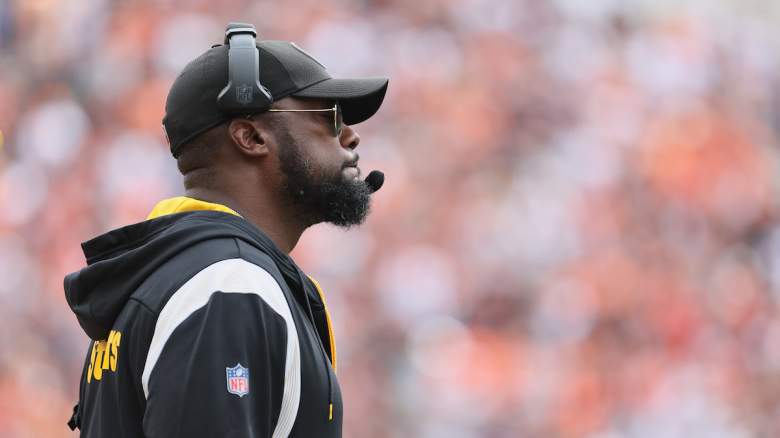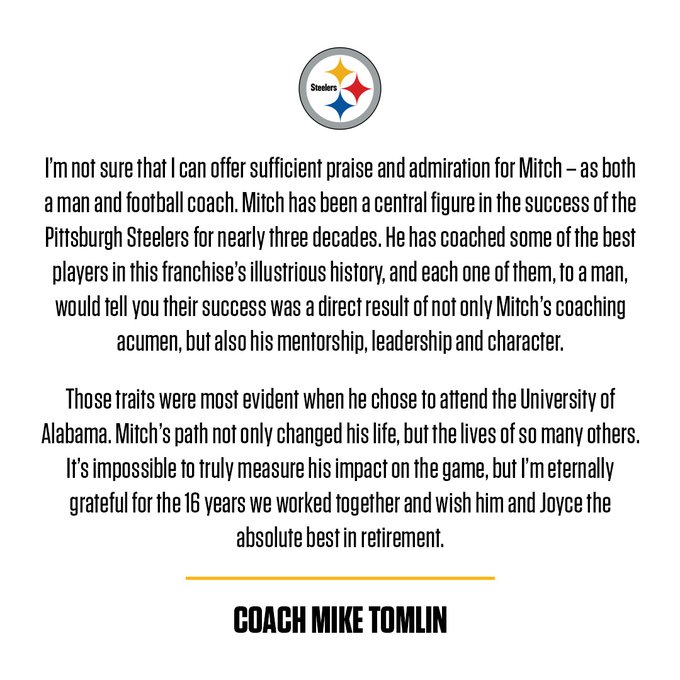
Getty Mike Tomlin on the sideline.
The Pittsburgh Steelers will be without the longest-tenured coaching staff member effective immediately. On February 15, the team announced that Mike Tomlin‘s assistant head coach is calling it a career.
John “Mitch” Mitchell, 71, was with the Steelers for nearly three decades, primarily serving as defensive line coach. For the past five seasons he worked in an off-field capacity, per Ray Fittipaldo. He was hired in 1994 by Hall of Fame coach Bill Cowher and retained by Tomlin when he took over in 2007. Mitchell was promoted to assistant head coach in 2018, a role he fulfilled through the end of the 2022 season.
The Steelers had the NFL’s best run defense four times during Mitchell’s tenure as defensive line coach, per Fittipaldo, and he coached several Pro Bowl players, including Cam Heyward, Aaron Smith, Brett Keisel and Joel Steed.
“I’m grateful to the Rooney family for the wonderful opportunity to coach and work for the Steelers for nearly 30 years,” Mitchell said in a retrospective by Teresa Varley and Bob Labriola. “It was truly an honor. I’d also like to thank coach Tomlin for giving me the opportunity to stay with the franchise when Coach Cowher retired. I will treasure my time in Pittsburgh and appreciate everyone affiliated with the organization.”
The Steelers released the following statement from Tomlin:
I’m not sure that I can offer sufficient praise and admiration for Mitch — as both a man and football coach,” Tomlin said. “Mitch has been a central figure in the success of the Pittsburgh Steelers for nearly three decades. He has coached some of the best players in this franchise’s illustrious history, and each one of them, to a man, would tell you their success was a direct result of not only Mitch’s coaching acumen, but also his mentorship, leadership and character. Those traits were most evident when he chose to attend the University of Alabama. Mitch’s path not only changed his life, but the lives of so many others. It’s impossible to truly measure his impact on the game, but I’m eternally grateful for the 16 years we worked together and wish him and Joyce the absolute best in retirement.
Steelers owner and president Art Rooney II echoed similar sentiments about Mitchell:
“Coach Mitch has been a pivotal member of the Steelers organization, in a variety of roles, for the better part of 30 years. When you consider his path, as both a player and coach, Mitch created opportunities in football for young Black men that quite honestly didn’t previously exist. He has left an imprint on this franchise, and the sport and culture of football, that will continue well beyond his retirement.”
Humble Beginnings for Steelers Coach John Mitchell
While John Mitchell started with the Pittsburgh Steelers in 1994, his coaching career began a half-century ago. According to Steelers.com, famed Alabama head coach Paul “Bear” Bryant hired him as an assistant coach after graduation from the University of Alabama in 1972. His incredible journey to arriving at Alabama, where he became the first black African-American to play for the Crimson Tide, is detailed in Varley and Labriola’s retrospective.
He had stints in assistant roles at Arkansas and LSU before a three-decade NFL career started as an assistant under then-Cleveland Browns head coach Bill Belichick. His 29-year career with the Steelers included two Lombardi trophies in four appearances. He was also inducted into the Alabama Sports Hall of Fame.
Mitchell grew up in Alabama during segregation and spoke about it at length for his retrospective.
“It was pretty tough as a kid growing up, especially right there in Mobile and the state of Alabama,” Mitchell shared. “People talk now about confederate flags. At that time, confederate flags were everywhere, in the stores, shopping centers. If they had a confederate flag in the window or outside the door, that was a sign that people of color were not welcome.”
“At that time, schools were segregated,” he continued. “There were black schools and white schools. Transportation was segregated. Black people would pay the same as white people but had to sit in the back of the bus. If the bus was crowded, they had to get up and give their seat to a white person. They had separate restaurants, shopping. Black people, if you went to the movies, you had to go through the back door to get in and then you couldn’t sit in the front of the theater. You had to sit in the balcony.”
